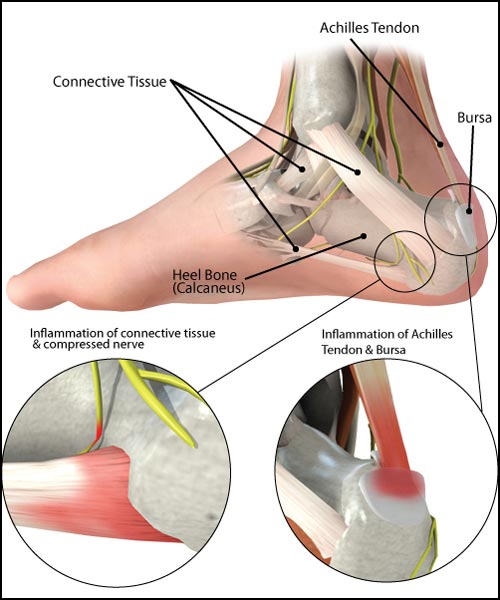Morton’s Neuroma
Morton’s Neuroma is a painful foot condition. It occurs when a nerve near the toes becomes compressed and inflamed. If diagnosed early, most cases of Morton’s Neuroma can be treated without surgery. However, surgery for the condition has a high success rate.
ANATOMY
In medical terms, your toes are called digits. They are numbered one through five. The big toe is the first digit, and your little toe is the fifth digit. Nerves travel through your foot to your toes to control movement and sensation.
Morton’s Neuroma develops most often between the third and fourth digits of the foot. This is the area where two nerves join together and become thicker. A ligament (deep transverse metatarsal ligament) holds the bones in the foot together and covers the nerve. Symptoms occur when the nerve is compressed between the ligament and the bottom of the foot.
CAUSES
The exact cause of Morton’s Neuroma is unknown. It results when the tissue surrounding the nerve between the third and fourth toes thickens, swells, and puts pressure on the nerve. Inflammation then develops.
People with bunions, flat feet, and hammertoes are susceptible to developing Morton’s Neuroma. Pressure from standing, walking, jumping and running or wearing high heeled, pointed toe, or tight-fitting shoes can contribute to the condition. High impact sports, such as racquetball, squash, or tennis, can lead to Morton’s Neuroma.
SYMPTOMS
Morton’s Neuroma can cause sharp pain, tingling, numbness, stinging, and burning between the third and fourth toes and the ball of the foot. It may feel as if a lump is inside the ball of your foot or that you have stepped on a bump. Your symptoms may be worse when you stand, walk, or put weight on your foot. Symptoms typically start gradually, come and go, and become worse over time.
DIAGNOSIS
You should contact your doctor if you have the symptoms of Morton’s Neuroma. Early treatment can help avoid future surgery. Your doctor can diagnose Morton’s Neuroma by reviewing your medical history, examining your foot, and taking x-rays.
Your doctor will feel your foot to determine if there are any bumps or masses, and to pinpoint the symptoms. X-rays may be used to rule out other conditions, such as a fracture or arthritis. A magnetic resonance imaging (MRI) scan may be used to learn more about the size and location of the neuroma.
TREATMENT
There are a variety of treatments for mild to moderate Morton’s Neuroma. The treatment you receive will depend on the severity of your symptoms. Rest, wearing appropriate shoes, and over-the-counter pain medications, such as ibuprofen, can help reduce swelling and pain. Padding or shoe orthotics can help reduce pressure.
If conservative treatments do not provide relief, your doctor may inject your foot. Corticosteroid medication is used to reduce pain and inflammation. Alcohol sclerosing injections are used to harden the nerve area and relieve pain.
SURGERY
Surgery may be recommended when other treatments do not provide symptom relief. There are a couple surgical options for Morton’s Neuroma, release surgery and removal surgery. Release surgery involves making an incision on the top of the foot to access the deep transverse metatarsal ligament that covers the nerve. By making an incision in the ligament, the pressure is released from the nerve.
Removal surgery is performed through the bottom of the foot. The neuroma is easier to access this way. The neuroma is surgically removed, and the incision is closed with stitches.
RECOVERY
Recovery from surgery depends on the procedure that you received. Because release surgery is performed from the top of the foot, there are no stitches on the bottom of the foot and walking may be resumed soon after the procedure. Because removal surgery uses stitches on the bottom of the foot, you may need to use crutches for a time after surgery. No matter what surgical or nonsurgical treatment you receive, healing is an individualized process, and your doctor will let you know what to expect.
PREVENTION
Contact your doctor if you suspect that you have Morton’s Neuroma. Early diagnosis and treatment can help avoid future surgery. You may help prevent Morton’s Neuroma by modifying your activities to reduce high-pressure repetitive forces to your feet. Wear low heel shoes with wide toe boxes, padding, and orthotics as recommended by your doctor.




